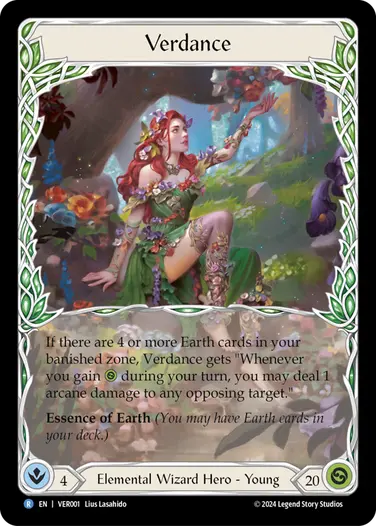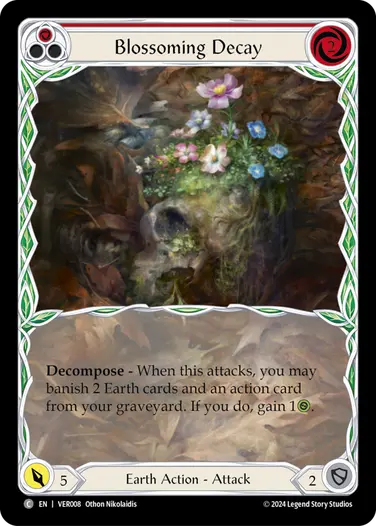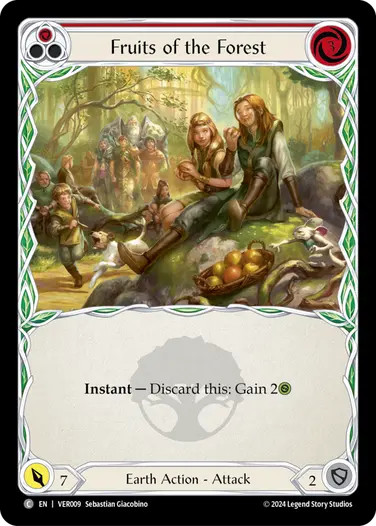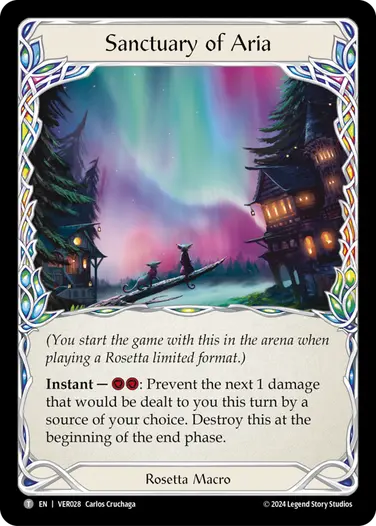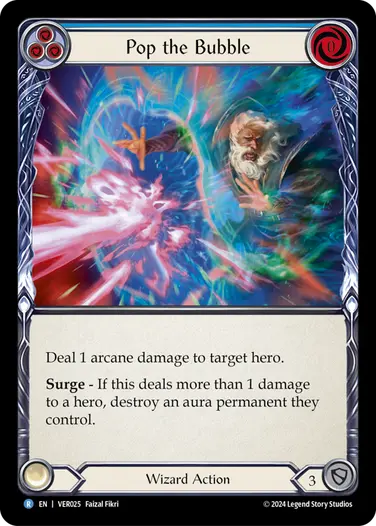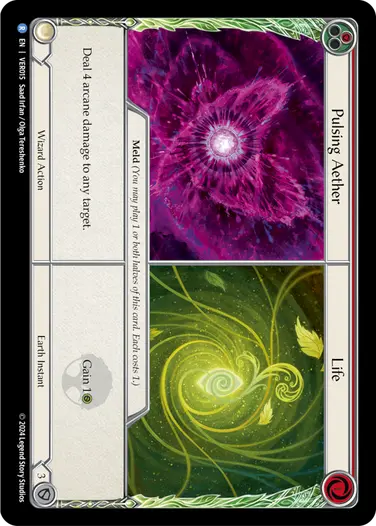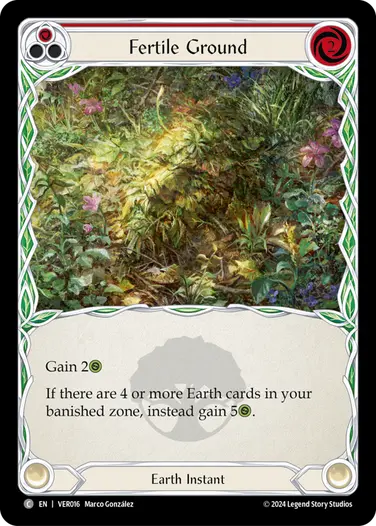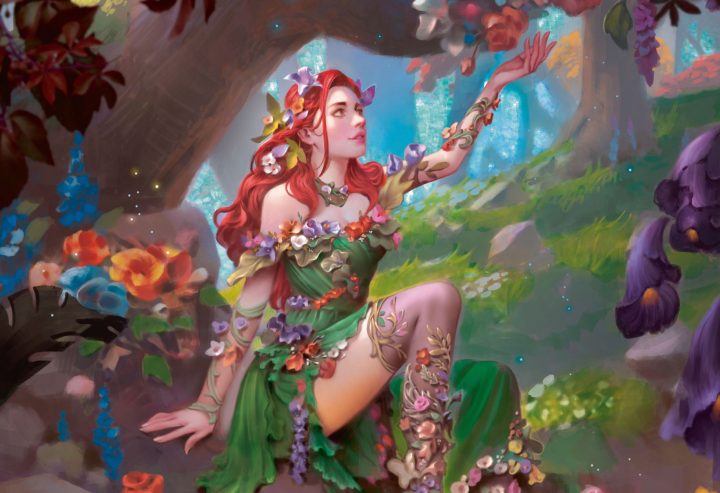Verdance is an Elemental Wizard empowered by Earth! She plants cards in the graveyard, then harvests the flourishing new life in order to heal and deal!

How to Play Verdance
Early in the game your main goal should be to stay alive and work towards getting your hero ability online. Defend heavily in order to fill your graveyard with Earth cards. Earth cards can be identified by their green border pattern and Earth symbol in the card text. Keep an eye out for cards with the keyword decompose as these are crucial for moving Earth cards from your graveyard to your banished zone.
When you play a card with decompose, you choose 2 Earth cards and 1 action card to banish. You have to select exactly 3 cards. It doesn’t matter what types the Earth cards are, nor does it matter if the action card is an Earth or not. For example, if you have defended with Helm of Lignum Vitae, it can be decomposed as an Earth card. Verdance’s ability requires you to have 4 or more banished Earth cards, so you will need to decompose twice during the game at the very least. This is why it’s a good idea to choose a non-Earth card as your action card, rather than a third Earth card, because otherwise you risk not having enough Earth cards in graveyard for future decomposes.
Once you have 4 banished Earth cards, it’s time to heal and deal! Use cards that gain life during your own turn and Verdance will deal 1 arcane damage to them (more on this damage type below). Stay alive while you chip away at your opponent’s remaining life total and eventually you will bury them in the ground! Don’t be afraid to rely on good old fashioned attack actions throughout the game as well – Verdance is a battlemage, and is just as happy throwing out a 7-power attack as she is sending out a burn spell.
Arcane 101
Verdance is a Wizard, which means she has a variety of ‘burn spells’ at her fingertips. These burn spells are Wizard actions that deal arcane damage. Arcane damage is a special form of damage that can’t be defended by regular means. Because Wizards have a naturally strong affinity for aether, they can deal larger bursts of arcane damage than other arcane classes, and often it’s an unavoidable lethal burn spell that will bring a Wizard victory.
Stopping your opponent’s arcane damage is a little trickier. You start the game with Sanctuary of Aria, a special token that allows you to pitch 2 resources to stop 1 point of damage, regardless of type. You can activate this multiple times in a turn, but once that turn is up, your safety net is gone! Due to the high cost of preventing arcane damage, most of the time you’ll want to use Sanctuary of Aria on the very first turn when you’re going second, or as a last resort. Other cards, like Fruits of the Forest, can discard themselves to gain life as a counter measure. Often, the best solution is just to take out the opponent before they get the chance to deal lethal damage.
Many Wizard cards in your deck have the keywords amp or surge. When a card amps, it means the next time you deal arcane damage during that turn, it deals an extra amount. Amp will always have a number next to it indicating how much extra damage is added. Amp only applies during the same turn it is activated, so if you end your turn without dealing anything, any amps you activated that turn will be lost. Surge is a payoff for amping, it gives you a bonus effect if you deal arcane damage greater than the original amount on the card. You only get the surge effect if your opponent takes the specified amount of damage. For example, if you amp 1 then play Pop the Bubble, and your opponent uses Sanctuary of Aria to prevent 1, taking 1, you will not get the surge effect.
Tricky Stuff
As soon as your hero ability is turned on, it is always active, even if you’re playing a card that is both decomposing your third and fourth Earth cards and at the same time gaining you life, such as Blossoming Decay. It’s important to note that Verdance’s hero ability occurs in two steps. Firstly, you play a card or activate an ability that gains life. You gain the life first. Then once life has been gained, Verdance will trigger, and deal 1 arcane damage. Some examples of life gain timing you may come across in the Verdance Blitz Deck are:
- You have 4 Earth cards in your banished zone and a Harvest Season in play from the previous turn. You intend to use Staff of Verdant Shoots. At the start of your action phase, Harvest Season is destroyed and you gain 3 life. Then, Verdance deals 1 arcane damage. There was not a window to activate Staff of Verdant Shoots in order to amp the damage dealt this way, because it occurred before you could take an action.
- You have 4 Earth cards in your banished zone, and both you and your opponent are on 10 life. You play Fyendal’s Fighting Spirit. Before the attack resolves, your opponent activates the instant ability of Fruits of the Forest, discarding it to gain 2 life. Fyendal’s Fighting Spirit becomes an attacking card, and since you now have less life, you gain 1 life. Then, Verdance deals 1 arcane damage. If the opponent had waited until Fyendal’s Fighting Spirit had resolved before activating Fruits of the Forest, then they would have avoided the arcane damage.
- You have 4 Earth cards in your banished zone, you are on 1 life, your opponent is on 2 life. You activate Hold Focus in order to amp 1, and your opponent decides to try and kill you with an instant Shock from hand before it resolves. Before Shock resolves, you activate the instant ability of Fruits of the Forest. First, you gain 2 life. Then, Verdance deals 1 arcane damage. Then, Shock deals 1 arcane damage to you. Finally, Hold Focus resolves, and its amp effect will apply the next time you deal arcane damage this turn. It did not apply to the arcane damage you just dealt with Verdance, because it occurred before the amp existed.
Now let’s talk about that weird sideways card in your deck. Split-cards are a new type of card introduced in Rosetta, which are essentially two cards in one! You are allowed to play either half, or if it has the keyword meld, you can play both. If you choose to play both halves, you need to pay the resource cost separately for each half. This means you can pay 1 to play Pulsing Aether, or you can pay 1 to play Life, or you can pay 2 to play Pulsing Aether and Life.
When you play both halves of a split-card, they resolve right-to-left. This means if you play both halves of Pulsing Aether // Life, the Life happens first (then, Verdance’s ability if it’s active), then the Pulsing Aether. Note that while the Life half is an Earth instant and the Pulsing Aether half is a non-Earth action, they are still considered to be a single card for the purposes of decomposing.
Lastly, each half of a split-card can only be activated if the game rules allow it. This means that even though Life is an instant, you can’t play Pulsing Aether during your opponent’s turn because it’s an action that needs to be played during your action phase.
How to Win with Verdance
Early in the game your focus should be to defend heavily and gain life, while you wait for your decompose cards to show up. Don’t feel like you have to save all your life gain for when your hero ability is online, survival is more important. Fertile Ground is an exception, as it’s often better to pitch or arsenal for when you have 4 or more Earth cards in your banished zone. Make good use of your 7-power attacks, as these will carry you through to the end.
Once your hero ability is live, look for strong combinations of cards to activate during your action phase with an efficient resource cost, such as combining Fertile Ground, Harvest Season, and/or 1-cost burn spells. This way you’ll get the most value, stay alive, and drain your opponent’s life to lethal range. Don’t be afraid to take damage in order to send more back, because while life gain keeps you around and deals arcane, it doesn’t pressure your opponent into defending. Use your life gain as an excuse to play greedy attacking hands rather than just continuing to defend everything and relying only on your hero ability for damage. Remember, it doesn’t matter how much life you have if you run out of cards.
Amp and surge are key components for both dealing with your opponents threats, and closing out the game. Sometimes it’s worth using your amp just to bait the opponent into using their prevention early. For example, you might use Hold Focus on an Aether Quickening, with one card in hand and resources floating, threatening even more damage if surge activates. Your opponent might decide to use their Sanctuary of Aria to stop you getting go again, but you were always intending to arsenal that card anyway, and now they don’t have protection. Perennial Aetherbloom and Staff of Verdant Shoots is a powerful burn spell combo that can recycle itself if your opponent doesn’t prevent it. Try to keep at least one copy in your deck, as often by the time you draw it again, it’s just enough for lethal!
